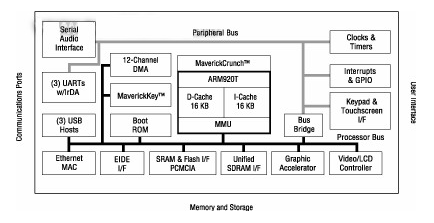What is the role of high-performance embedded ARM MPU in medical electronic systems?
At present, the global medical electronics industry is gradually showing attractive development prospects, and the speed of product replacement is increasing. At the same time, due to the special characteristics of medical electronics, the performance, power consumption, reliability and integration of components and so on All have put forward extremely high requirements. The world's leading semiconductor manufacturers have launched a series of products suitable for this application area.
A 32-bit embedded microprocessor (MPU) based on the ARM core, with its high performance, low power consumption, and abundant on-chip resources, has become the first choice for many medical electronics product development platforms. Among them, Cirrus Logic's flagship product, EP9315, is currently the most integrated ARM processor. This processor uses ARM920T core, has a high performance of 200MHz clock frequency, built-in mathematical coprocessor, graphics acceleration engine, integrated rich peripheral circuits including IDE and PCMCIA interfaces, etc., to meet industrial standards and attractive The cost-effective performance makes it stand out from many embedded microprocessors, making it an ideal choice for the next-generation medical electronics product development platform.
There are many types of medical electronic products with different functions. Classified according to its application, including ultrasound imaging systems, multi-parameter monitoring systems, conventional inspection systems, etc. Today's medical electronic products always use the latest technology in order to obtain powerful performance to complete increasingly complex algorithms and numerous functions to meet the needs of continuously upgraded clinical applications. Its application requirements are mainly manifested in the following aspects:
1. With the gradual improvement of product performance, hardware is required to complete a large number of algorithms and logical operations. Products such as B-ultrasound and high-end monitors have begun to use FPGA devices extensively;
2. Wide application of large-sized display screens and touch screens. At present, ultrasound products, multi-parameter monitors and some inspection products such as hemocytometers, biochemical analyzers, etc. mostly use large-sized display screens in the range of 10 'to 15', with resolutions of 640 × 480, 800 × 600 or 1024 × 768 . In addition, touch screens are becoming more and more widely used in this field;
3. Large amount of data storage. Products such as B-ultrasound and color Doppler ultrasound have started to connect standard IDE hard disks due to the growing application layer software and the need for image depth storage;
4. The need for peripheral interfaces. Such as network interface and USB interface are indispensable in medical electronics;
5. Audio Codec application. For example, in the color Doppler system, the audio codec is needed to complete the encoding and decoding of Doppler blood flow audio data;
6. The advent of portable products has increased the degree of attention to power consumption.
The above series of application requirements place higher requirements on the microprocessor platform. Engineers often want faster speed, higher integration, and lower power consumption when selecting models. Especially in terms of high integration, not only can it ensure Convenience and reliability of design work and effective cost control.
The microprocessor is the core control device of the system, and its indicators are often the most concerned by engineers when selecting. Compared with other embedded microprocessors based on ARM9 core, Cirrus Logic's EP9315 has obvious advantages in terms of overall performance, on-chip peripheral interfaces, and system cost.

The EP9315 specifications are as follows:
1. Integrated ARM920T core clocked at 200MHz and memory management unit (MMU) supporting Linux, Windows CE and many other embedded operating systems. It has 16KB instruction cache and 16KB data cache;
2. Embedded MaverickCrunch math coprocessor, which significantly improves the operation speed of single / double precision integer and floating point, and helps the operation of complex algorithms. This is very rare in other ARM microprocessors;
3. Integrate 2D graphics acceleration engine, enhance the image processing ability of the system through block copy, block fill and other operations. The image acceleration engine is independent of the microprocessor and does not increase system overhead. It can support a resolution of up to 1024 × 768, which basically meets the large-screen applications of most medical electronic products.
4. Abundant on-chip / peripheral interface resources can fully meet the current application requirements of various medical electronic products. From Table 1, you can see the various parameters of Cirrus Logic's full range of microprocessors based on ARM9.
In order to cooperate with customers' synchronous development, shorten the research and development cycle, and improve the design quality, Cirrus Logic set up a technical support center composed of more than 20 engineers in Beijing to take charge of the software and hardware technical support for EP93xx series products. Not only can provide design reference such as development board, but also provide a large number of software support services, including BSP source code under Windows CE platform, driver source code and complete kernel source code and development kit for Linux platform. Peter Cirrus Logic China and Hong Kong General Manager said: "We not only provide customers with chips, but more importantly, we can provide a full range of solutions and technical support in development. There is no doubt that this will reduce the development difficulty for customers Great help. "
At present, some companies have selected EP9315 as the processing platform of the system. Emperor's hardware designer said: "We chose EP9315 as the platform for B-system upgrades, mainly focusing on the following three points:
1. Integrated mathematical coprocessor, compared to similar products, the algorithm processing speed will be much faster;
2 . Supports high resolution and meets the requirements for image display without adding an additional video codec chip;
3. Provides an IDE interface because hard drives and DVD drives will be used in B-ultrasound products. "
If you want to know more, our website has product specifications for the embedded ARM MPU, you can go to ALLICDATA ELECTRONICS LIMITED to get more information

